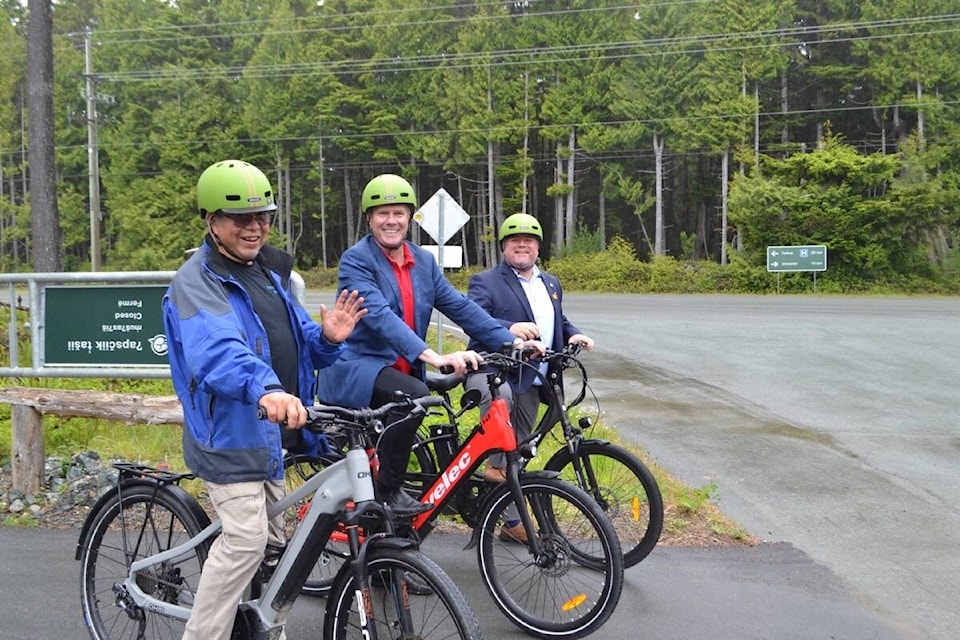Parks Canada and local First Nations leaders officially unveiled the new $51 million ʔapsčiik t̓ašii (pronounced ups-cheek ta-shee) multi-use pathway on June 28 at a special welcome ceremony at Combers Beach in the Pacific Rim National Park Reserve.
The 25-km pathway spans the length of the Pacific Rim National Park Reserve’s Long Beach unit and is located in the traditional territories of the Tla-o-qui-aht First Nation and Ucluelet First Nation. Since the project was first pitched in 2016, Parks Canada has worked closely with and Elders’ Working Group on planning, development, and building it.
Tla-o-qui-aht elder Barney Williams opened the event with a Nuu-chah-nulth language prayer and chant. He acknowledged the loss of loved ones in the communities, and went on to thank Parks Canada for showing respect by “going to the right people to ask permission.”
“So I say welcome to you. And to the people of the National Park. I want to thank you for allowing us to come together as Nations to work with you to create an understanding that we can work together. That we can move forward in a good way,” said Williams.
The Elders Working Group named the pathway ʔapsčiik t̓ašii, which means “going the right direction on the path.”
“This road was our vision our people had to create healing for our people. Not just our people, but people throughout the world,” said Williams.
Newly elected Tla-o-qui-aht chief Elmer Frank addressed the crowd at the June 28 ceremony.
“There is a willingness with our Nation to work on relationship building with Canada. Canada uses this term “reconciliation” and I think that’s a term that not all First Nations support because we’ve never had a relationship. We’ve never had that relationship,” said Frank.
“I think today is a proud venue for being able to do that. That we as a Nation are willing to move forward and to heal collectively,” he said.
Ucluelet First Nation elected president Charles McCarthy spoke about the trail as an economic driver for small businesses and the ability to move visitors to have a safe, new experience.
“For us, it creates the ability for just not just our people to utilize the trail, but tourists from Ucluelet and Tofino and (elsewhere). We all have a common path that we share that brings our communities together at this point and ʔapsčiik t̓ašii is where it connects the two communities,” said McCarthy.
“We are intertwined with Tla-o-qui-aht through marriage and close relations. This is something we’ve achieved together and this is an important for me to see that because the only thing we have left is our land and our right to our land. We will always acknowledge the owners of the land and their territories too,” he said.
John Aldag, Member of Parliament for Cloverdale—Langley City, shared remarks on behalf of the Government of Canada.
“National Parks represent the very best that Canada has to offer including the history, cultures and contributions of Indigenous peoples. I’m please to join Tla-o-qui-aht First Nation and (Ucluelet First Nation) in welcoming visitors and residents to experience ʔapsčiik t̓ašii,” said Aldag, noting that he spent 34 years working for Parks Canada prior to entering politics.
“Parks Canada as an organization has done so immense work on reconciliation and relationship building. I think there is so much work that needs to continue and today is such an honour to be here to see the work that has happened as the communities come together to make this a living demonstration of the work that needs to be done as we work together,” he said.
While the multi-use pathway is connected to Tofino at the northern end of the the Long Beach Unit, about one-kilometre of trail remains to be built to connect the southern boundary of the ʔapsčiik t̓ašii trail to Ucluelet. The raw land lies on Alberni-Clayoquot-Regional District (ACRD).
“Parks Canada has provided a letter of support to the ACRD as they have progressively been applying for government funding at the provincial and federal levels,” reads a statement from Park Reserve management.
According to a representative on the ACRD board of directors, two grant applications are in process: $500,000 from the Provincial BC Active Infrastructure Transportation fund and $300,000 from the Federal Active Transportation Fund with Infrastructure Canada. If both applications are successful, the ACRD will have enough funds to complete their section of the multi-use path.
The completion of this “missing link” will ultimately connect Tofino and Ucluelet by a roughly 41-km pathway for cycling, walking, and commuting on the West Coast.
RELATED: Indigenous owned Ebike rental opens at the Tofino-Ucluelet Junction
nora.omalley@westerlynews.ca
Like us on Facebook and follow us on Twitter.
